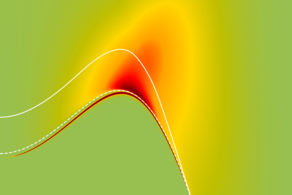Using chirped pulses to simultaneous address multiple quantum dots
- Reiter

In the field of quantum technology, scaling up poses a significant challenge. This is applicable to various problems, such as quantum computing, where the size of operations is limited, and quantum communication, where information or key rates need a boost. Single photons are a key component of quantum communication. They are generated on demand by quantum dots with exceptional quality. To boost the photon rate, one possibility would be to use several quantum dots. Unfortunately, quantum dots are not uniform and each quantum dot is slightly different from the other. Adjusting the exciting laser individually can be impractical. In this study, we propose a solution that enables the robust excitation of quantum dots: the excitation with chirped laser pulses making use of the adiabatic rapid passage (ARP) scheme.
In this publication, we show that we can address two quantum dots simultaneously with the same laser pulse. For resonant excitation, that would be inefficient due to the fluctuation of the dot parameters. To accomplish the simultaneous excitation, we generate a chirped laser pulse and consider two dots separated a few hundred nanometres. Because of the ARP scheme, we can excite two quantum dots, even though their energies are not the same. The experimental results are complemented by theoretical calculations that highlight the role of phonons in enhancing the detuning windows where simultaneous excitation is allowed.
Our technique exhibits the capability to produce four photons with a single excitation event. Importantly, this approach is not limited to two quantum dots but can be extended to an ensemble of quantum dots. The application of this technique holds great promise in boosting the photon rate for use in various quantum communication applications.
The paper results from a collaboration with the Photonics group from Innsbruck with samples from the Rastelli group from Linz and the theoretical group from Martin Axt from Bayreuth.







